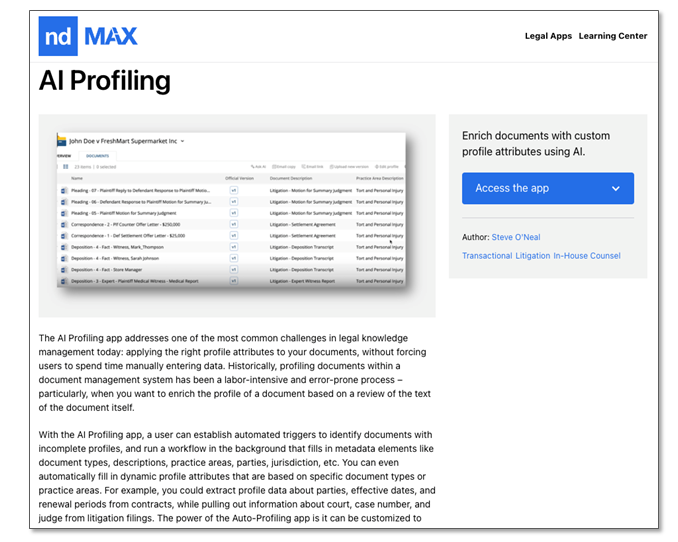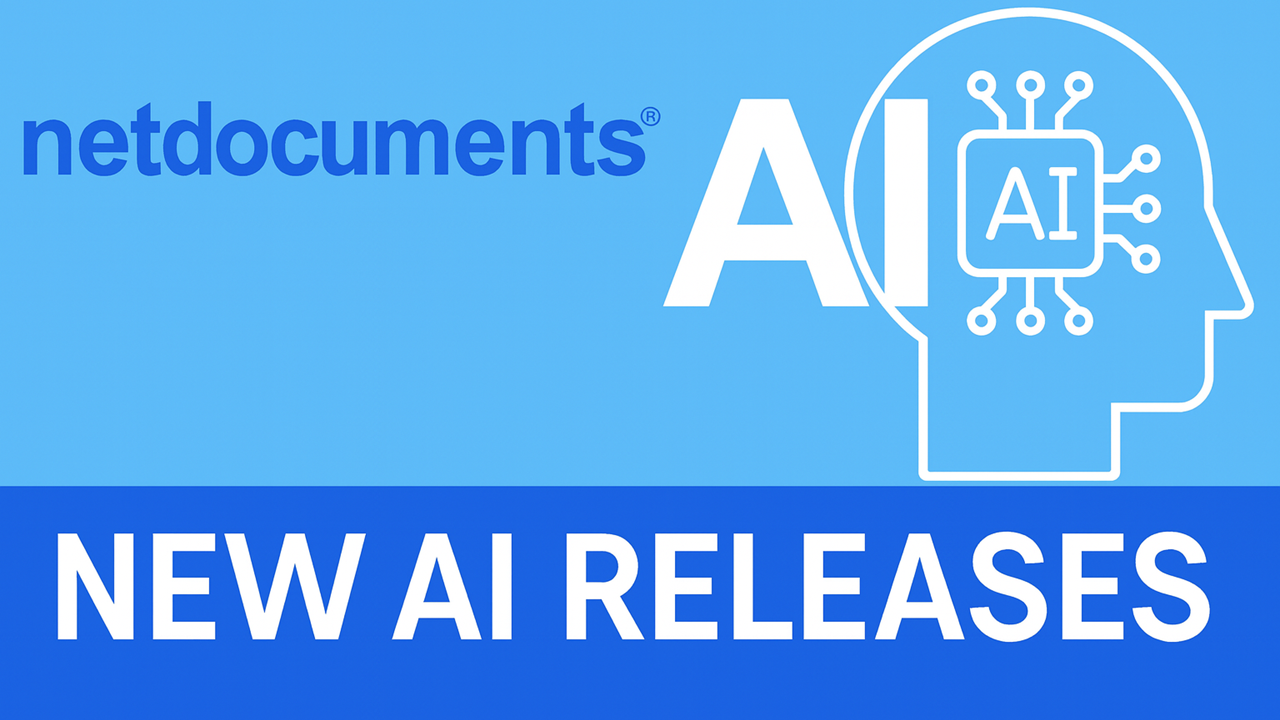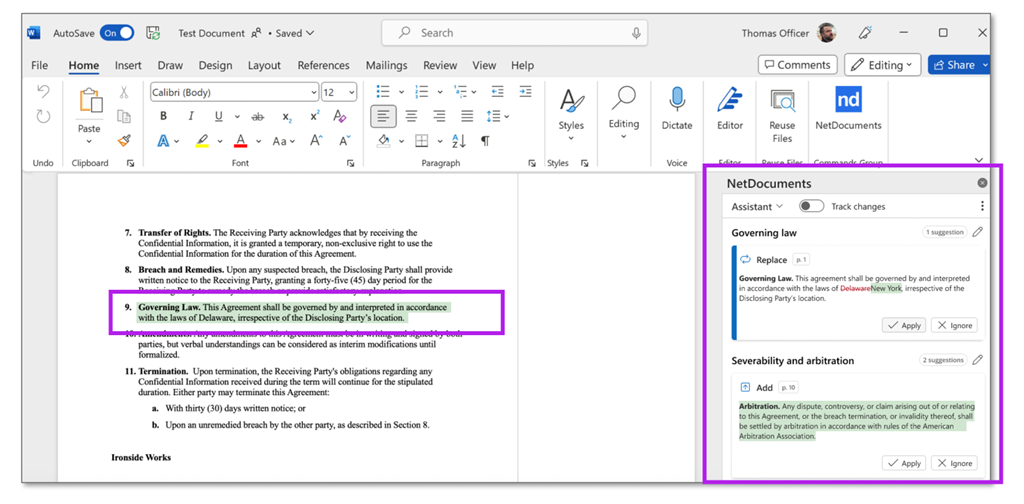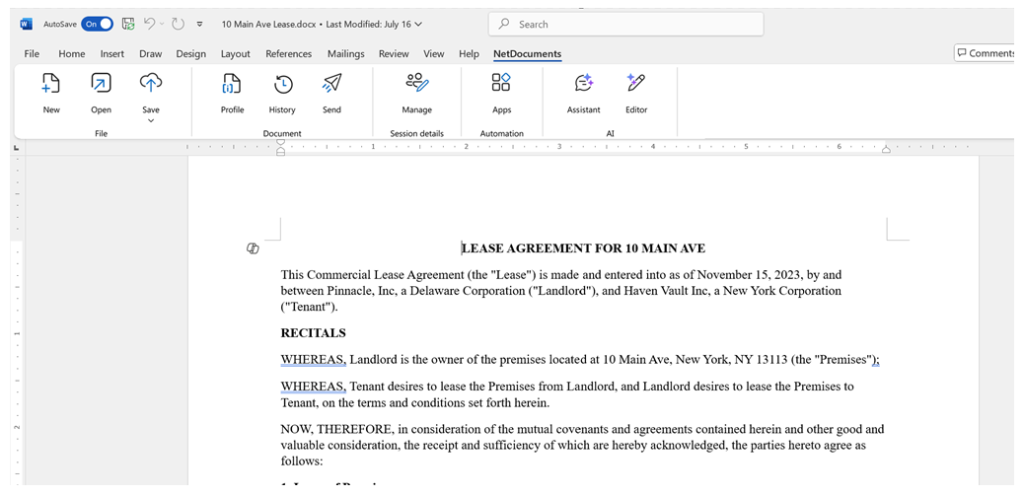NetDocuments today announced significant enhancements of its document management system, introducing AI-powered document profiling capabilities and the company’s first agentic AI tool for editing documents directly within Microsoft Word.
The new features come as part of the company’s ongoing push to embed artificial intelligence more deeply into legal workflows while enabling legal professionals to maintain the security and governance standards they require.
The Salt Lake City-based company unveiled the enhancements during a media briefing last week ahead of ILTACON, the annual conference of the International Legal Technology Association, which kicks off later this week in National Harbor, Md.
Automating Metadata Extraction with AI
The centerpiece of the announcement is AI Profiling, a background application that automatically extracts and populates metadata from legal documents without manual intervention. The system can identify document types, extract key information such as parties, dates, payment terms, and jurisdictional details, and organize content according to customizable parameters defined by individual firms.
 “Great AI outcomes depend on knowing your data, and AI Profiling lets you classify and extract metadata on every document exactly the way you want, ensuring that your content is structured, secure, and reliable,” said Dan Hauck, chief product officer at NetDocuments.
“Great AI outcomes depend on knowing your data, and AI Profiling lets you classify and extract metadata on every document exactly the way you want, ensuring that your content is structured, secure, and reliable,” said Dan Hauck, chief product officer at NetDocuments.
The technology addresses a persistent challenge in legal document management, where busy professionals often upload documents without completing profile fields, leaving metadata fields blank. Traditional approaches to collecting this metadata required either manual data entry or legacy machine learning systems that needed extensive training datasets and rigid rule structures.
During a demonstration, Scott Kelly, NetDocuments’ head of AI, showed how the system can process multiple documents simultaneously, automatically populating fields such as document descriptions, effective dates, governing law, renewal terms, and even complex payment structures.
The example used licensing agreements and non-disclosure agreements for a fictional client, Quantum Logics, showing how the system extracted specific details like a “$25,000 setup fee” from contract language.
The AI Profiling capability extends beyond simple document classification. Kelly demonstrated how firms can create custom attributes tailored to their specific practice areas, whether handling intellectual property licensing, litigation documents or regulatory filings. The system can extract thousands of different data points depending on organizational needs, using large language models rather than requiring pre-trained, domain-specific models.
“You’re not confined to just the parties, effective date, expiration date, governing law, renewal terms and payment terms,” Kelly explained. “You can really have it customized to whatever custom attributes that you care about.”
Background Apps
Building on the same technological foundation as AI Profiling, NetDocuments introduced Background Apps, which are automations that operate continuously to enhance content throughout the document lifecycle.
These applications can extract structured data from contracts, leases, and pleadings; promote reusable knowledge assets; classify sensitive content such as personally identifiable information and protected health information; and automate onboarding workflows, the company says.
The background processing approach allows firms to apply AI capabilities at scale without disrupting daily workflows. Early implementations have involved customers processing millions of documents, with one firm using the technology to automatically apply different retention policies across tens of millions of documents based on content analysis.
Hauck said that this approach differs significantly from legacy systems that required moving documents to separate platforms for AI processing. “This is all happening baked into the document management system itself,” he said.
Agentic AI for Automated Editing
Today’s second major announcement introduces NetDocuments’ first agentic AI tool, which integrates directly into Microsoft Word to perform document editing tasks based on plain-language instructions.
The tool represents a shift from conversational AI interfaces toward task-oriented agents that can take specific actions within documents, the company said.
The Agentic AI Editing Tool allows users to provide instructions such as updating pricing terms across multiple templates, standardizing jurisdictional language across non-disclosure agreements, or modifying settlement terms.
The system then generates tracked changes within Word documents, maintaining the formatting and review processes that legal professionals require.
“Whether restructuring clauses or updating terms, legal teams can now move from idea to action without ever leaving their documents,” the company said.
Kelly demonstrated the capability by showing how a user could instruct the system to modify the closing date and purchase price across multiple documents. The AI assistant evaluates the instruction, determines that document editing is required, and queues up tasks for each selected document. When users open the documents in Word, the NetDocuments add-in loads suggested changes that appear as tracked edits.
“This is the kind of instruction you would actually give to maybe your own paralegal or junior associate,” Kelly explained. “But now you can use a dedicated legal assistant to do that.”
The editing feature is the first tool to be announced as part of NetDocuments’ broader Legal AI Assistant, which the company plans to expand with additional agentic capabilities including clause extraction and timeline generation.
Enhanced Microsoft 365 Integration
Alongside the AI announcements, NetDocuments said it has expanded its integration with Microsoft 365, including native cloud storage integration that allows users to access NetDocuments directly through Word’s file management interface across desktop, mobile and web platforms.
The company also introduced a new M365 add-in ribbon for performing complex NetDocuments actions and native co-authoring capabilities for desktop users.
The integration improvements address workflow efficiency concerns by reducing the need to switch between applications, Hauck said during the briefing.
“We know lawyers spend a lot of time in Microsoft Word,” he said, “so we’ve been adding a lot of capabilities to support those workflows.”
Bring AI to Your Content
Josh Baxter, NetDocuments CEO, said these and other updates are all part of a strategic vision to embed AI capabilities into existing workflows rather than offer standalone AI applications.
Related: LawNext Podcast: NetDocuments CEO Josh Baxter and CTO Alvin Tedjamulia on Success in the Cloud.
“We are bringing AI to your content versus content to your AI,” Baxter said.
He framed these developments within the legal industry’s broader transformation, describing the legal sector as facing “maybe the biggest inflection point we’ve ever faced.” He argued that successful firms will be those that reimagine how work gets done rather than simply upgrading existing systems.
“Let’s be clear,” Baxter said. “The firms that are going to lead us into the next decade won’t be the ones who simply choose to upgrade what they currently have. They’ll be the ones who are reimagining how work gets done … This moment’s more than about technology. It’s about how firms define the role of content knowledge and governance.”
If you are attending ILTACON, you can visit NetDocuments at Booth 901, or attend its company update on Aug. 12 at 10:30 a.m. in the Cherry Blossom Ballroom.
 Robert Ambrogi Blog
Robert Ambrogi Blog

